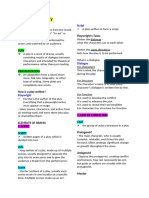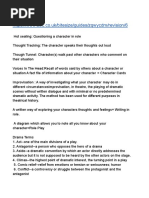Drama
Drama
Uploaded by
valerioansleyCopyright:
Available Formats
Drama
Drama
Uploaded by
valerioansleyOriginal Description:
Copyright
Available Formats
Share this document
Did you find this document useful?
Is this content inappropriate?
Copyright:
Available Formats
Drama
Drama
Uploaded by
valerioansleyCopyright:
Available Formats
DRAMA
• Comes from the Freek word dran which means “to do, or act”
• written to be performed by actors and watched by an audience
Two Types of Writing
• The dialogue that the characters speak
• The stage directions that tell the actors how to move and speak, describing the sets and props
Two Ways of Presentation
• As literature, the text of the play itself
• As performance, the production of the play in a theater
Two Types of Drama
Tragedy
• shows the downfall or death of a tragic hero, or main character
• In ancient Greek plays, the hero was a good person brought down by a tragic flaw, or defect in
character
• In a modern plays, the hero can be a normal person destroyed by an evil in society
• emphasizes human greatness
Comedy
• often shows a conflict between opposite age groups , genders, or personality types
• typical comedies involve confusion, jokes, and a happy ending
• stresses human weaknesses
How is a play written?
The author of a play is called a playwright. Everything a playwright writes must appear onstage.
A play in written form is called a script.
The playwright must write the dialogue, or what the characters say to each other in conversation, as well as the
stage directions, which tells how the play is to be performed.
Dialogue
Dialogue is what the characters say, and it is used to reveal their personalities i.e. Character Traits.
The name of the character who is to speak is listed usually in bold at the start of a line, followed by a colon.
Every time the speaker changes, a new line is started. Dialogue is necessary in order to develop conflict and
advance the plot.
Staging a Play
Drama is more than just the words on a page.
The production of a play involves directing the way the characters move, what they wear, the lighting, and the
scenery.
Staging is the practice of putting on the play. Some of the details of staging may be included in the stage
directions, however, the director and the producer take what the playwright has described and bring it to life
with their own ideas.
Sets
Sets are the scenery, backdrops, and furniture that create the setting.
A production may have different sets for different scenes. For example, some scenes may take place outside in
the street, while others may take place in a character’s living room. Some scenes may take place during the day,
while others may take place at night.
Props
Props are things like books, telephones, dishes, and other items that actors use onstage during the performance
to support the action.
Stage Directions
Stage directions are notes in the script usually written in italics and enclosed in parentheses or brackets.
They usually describe where and when a scene takes place (setting), how the characters should say their lines,
and how the characters should move onstage.
They may explain the character’s mood or how the character is feeling.
Stage directions may also describe sets, costumes, props, lighting, and sound effects.
Stage directions use certain terms to describe the stage. Look at the following slide and see how.
Audience
Downstage Downstage Downstage
Left Center Right
Stage Left Center Stage
Stage Right
Upstage Upstage Upstage
Left Center Right
Dramatization
A dramatization is a play that was once a novel, short story, folk tale, biography, or other type of writing.
Some plays are completely new works.
Other plays are adapted from novels, short stories, or even from nonfiction.
A playwright takes scenes, characters, and action from an existing work and turns them into a play, or
dramatizes them.
Play
A play is largely divided up into parts, or acts.
The number of acts in a production can range from one to five, depending on how a writer structures the outline
of the story.
The length of time for an act to be performed can range from 30 to 90 minutes.
Acts may be further divided into scenes; in classical theatre each regrouping between entrances and exits of
actors is a scene, while today it describes a quick change of setting.
The actors and actresses who perform the play are known as the cast.
The people who build sets, manage lighting, or work backstage are called the crew.
Theatre Etiquette
All of the people involved in the production, both cast and crew, work very hard to be sure they give a great
performance.
All of the people involved in the production, both cast and crew, work very hard to be sure they give a great
performance.
It is the job of the audience members to help the performers give their best performance possible. The audience
can do this by practicing the rules of theater etiquette, which is how the audience should behave when
watching a play.
Rules of Theatre Etiquette
Be on time to the theater. Turn off cell phones upon arrival.
Be quite so other around you can hear the performance
You should use the restroom before the show begins, and not get out of your seat while the show is being
performed.
You should not eat, chew gum, or drink any beverages while watching the show.
While it is appropriate to respond to funny, shocking, or entertaining moments out loud, you should respect
others around you and their enjoyment of the play by not responding with loud, inappropriate reactions.
It is customary to applaud at the end of songs, and at the curtain call, when the actors come out to take their
final bows. Throughout the show, audience members may choose to applaud when something particularly
0utstanding has just been performed. Do not whistle or scream out to the performers except for a Bravo.
You might also like
- The Birthday Party Study Guide by Harold PinterNo ratings yetThe Birthday Party Study Guide by Harold Pinter13 pages
- Elements of Drama and Theater (Presentation) Author Staff Site Universitas Negeri Yogyakarta100% (1)Elements of Drama and Theater (Presentation) Author Staff Site Universitas Negeri Yogyakarta29 pages
- Introduction-to-Drama-PowerPoint Revised 2012No ratings yetIntroduction-to-Drama-PowerPoint Revised 201229 pages
- How To Study A Play: Dramatic TechniquesNo ratings yetHow To Study A Play: Dramatic Techniques3 pages
- Creative Writing Lesson 1 Elements of DramaNo ratings yetCreative Writing Lesson 1 Elements of Drama71 pages
- No. 5 CW 11 Elements of Drama To Be Discuss 1 SignedNo ratings yetNo. 5 CW 11 Elements of Drama To Be Discuss 1 Signed26 pages
- Lesson 6: Character, Setting, and Plot For A One-Act PlayNo ratings yetLesson 6: Character, Setting, and Plot For A One-Act Play13 pages
- Break a Leg!: An Actor's Guide to Theatrical Practices, Phrases, and SuperstitionsFrom EverandBreak a Leg!: An Actor's Guide to Theatrical Practices, Phrases, and SuperstitionsNo ratings yet
- Story The Little Bird Who Was Afraid To FlyNo ratings yetStory The Little Bird Who Was Afraid To Fly2 pages
- Common Adverb and Adjective CollocationsNo ratings yetCommon Adverb and Adjective Collocations9 pages
- Step Up To Ielts Self Study Students Book Table of ContentsNo ratings yetStep Up To Ielts Self Study Students Book Table of Contents2 pages
- Citations and References APA Style Instructions and Examples100% (1)Citations and References APA Style Instructions and Examples5 pages
- Ole Higue: The Story Is That The Ole Higue, The Guyanese Form of A Human100% (1)Ole Higue: The Story Is That The Ole Higue, The Guyanese Form of A Human6 pages
- Art and The Existential in en Attendant GodotNo ratings yetArt and The Existential in en Attendant Godot13 pages
- Abject Terrors Surveying The Modern and Postmodern Horror Film (Magistrale, Tony) (Z-Library)No ratings yetAbject Terrors Surveying The Modern and Postmodern Horror Film (Magistrale, Tony) (Z-Library)185 pages
- Bahasa Inggris 5: This Post Was Republished To MTSN KOTA PASURUAN at 3:49:41 PM 1/2/2020No ratings yetBahasa Inggris 5: This Post Was Republished To MTSN KOTA PASURUAN at 3:49:41 PM 1/2/20204 pages

























































































